Joan Spain Gallery, Perelman Building
Main Building
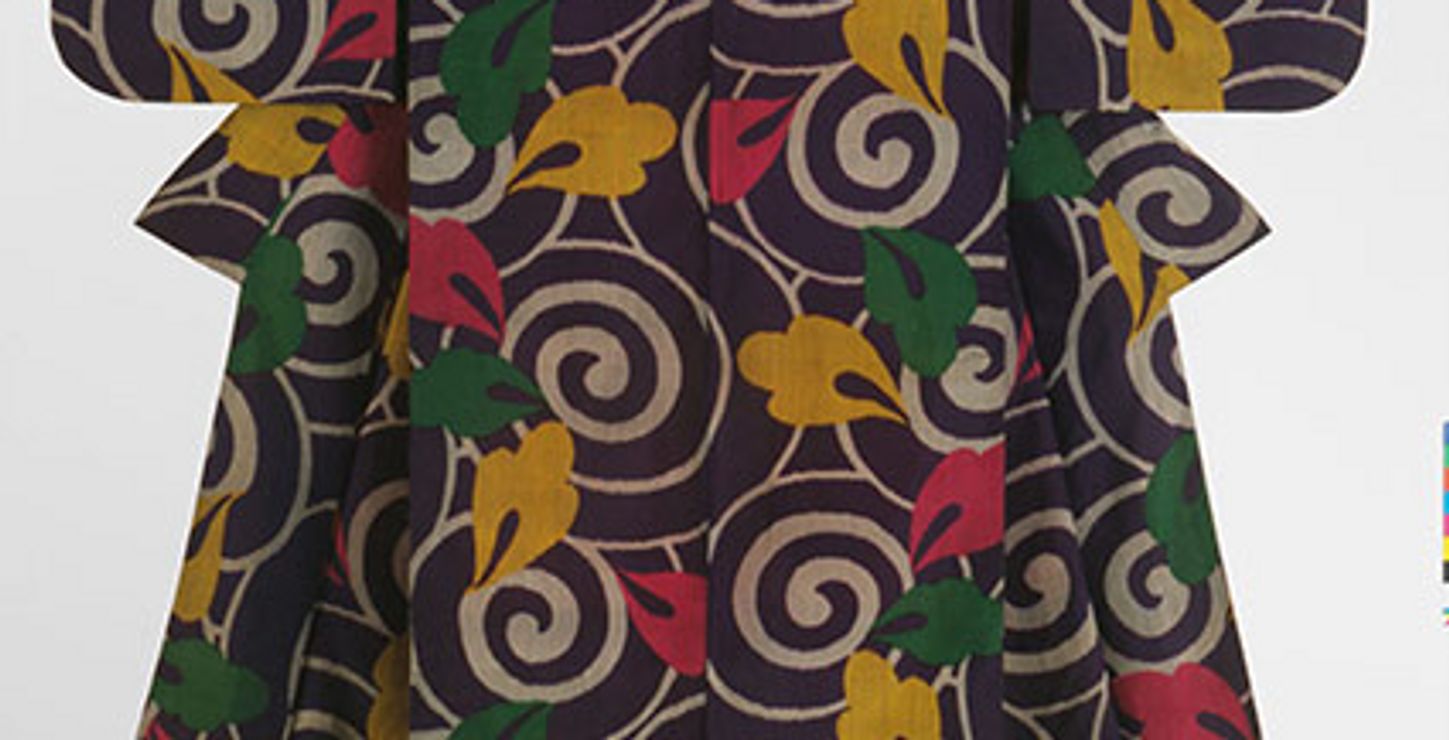
Woman’s Kimono Japan, 1920s–30s (late Taishō–early Shōwa period) Machine-spun silk plain weave with stencil-printed warp threads (meisen) The Montgomery Collection, Lugano, Switzerland
The Japanese kimono is celebrated worldwide for its elegant, distinctive silhouette. Though quintessentially Japanese, the kimono form has influenced fashion designers around the globe. This exhibition features approximately eighty-five kimono created in the early to mid-twentieth century, one of the most dynamic periods in the history of Japan's national costume. It includes formal, semi-formal, and casual kimono, haori jackets, and under-kimono (juban) worn by men, women, and children. Some of these garments reflect historical continuity in designs and techniques, while many others illustrate a dramatic break with aspects of kimono tradition, as themes and designs from Western art began to predominate over historical Japanese references. The exhibition begins by focusing on the early twentieth century, the final era of the "living" kimono, that is, when kimono still remained the dress of choice, worn daily by the majority of people in Japan; it continues through the 1940s, when Western clothes had replaced the kimono for everyday wear and the garment assumed a largely formal and ceremonial meaning. The outstanding kimonos in the exhibition, drawn from the internationally renowned Montgomery Collection of Lugano, Switzerland, have never before been exhibited in North America.
Traditional/Transitional Kimono
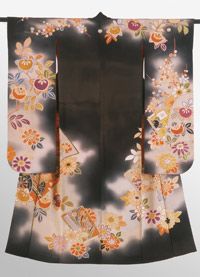
Young Woman's Formal Kimono (furisode) Japan, 1920s (late Taishō–early Shōwa periods) Silk crepe plain weave with hand-painted, rice-paste resist outlining (yūzen); gold paint; couched gold and silk thread embroidery The Montgomery Collection, Lugano, Switzerland
The first section in the exhibition focuses on kimono styles that reflect Japan's longstanding tradition of simple, elegant designs. Examples of formal kimono on exhibition include the long-sleeved furisode worn by single women, the shorter-sleeved tomesode worn by married women, and uchikake, the unbelted outer robes worn for ceremonial occasions including bridal wear. These kimono are hand-painted or stencil-painted onto handspun and hand-woven fabrics, and delicately dyed with soft, plant-based colors. Striped kimono were worn by young women for less formal occasions—in cafés, department stores, factories, and other places of business—and also as casual everyday wear for school or play. While commoners in the Edo period (1615-1868) had been prohibited from wearing garments dyed with the shibori tie-dyeing technique, by the early twentieth century these were extremely popular, as illustrated by two examples in the exhibition. Children's Kimono Styles
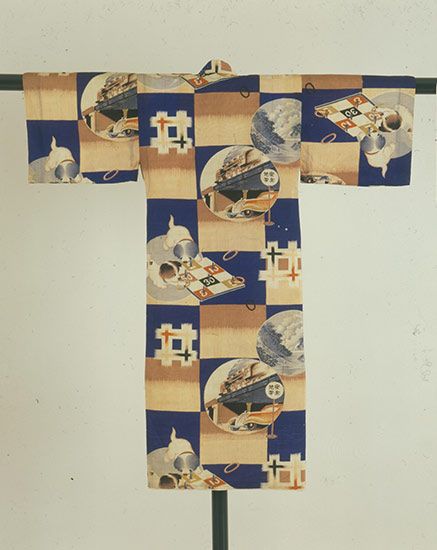
Young Boy’s Kimono Japan, 1930s–40s (early Shōwa period) Wool plain weave with stencil-printing on fabric surface, direct-dye method (kata-yūzen) The Montgomery Collection, Lugano, Switzerland
The children's garments in the exhibition include several casual kimono and jacket haori ensembles, one of which exemplifies the typical boy's school uniform of the early twentieth century. There are also several extraordinary formal kimonos, including examples of the miyamairi kimono draped over infant boys on the occasion of their first visit to the family's Shinto shrine. Also on view are young boys' kimono and under-kimono decorated with graphically explicit military designs or other symbols of modern times, such as cars, trains and airplanes. Young girls' kimono, in contrast, range from a charming long-sleeved furisode with delicate, hand-painted floral motifs to those with bold designs inspired by nature to a kimono and vest ensemble that uses traditional shibori tie-dyeing in a modern way. Men's Kimono Styles

Man’s Formal Jacket (haori) (shown inside out) Japan, 1930s–40s (early Shōwa period) Silk plain weave; lining of silk plain weave with hand-painted ink and brushwork (sumi-e) The Montgomery Collection, Lugano, Switzerland
Men's kimono in the late nineteenth and early twentieth centuries were extremely conservative, typically of solid colors or decorated with small motifs in dark colors. Men's under-kimono (juban), in contrast, recall the earlier, eighteenth-century "iki" fashion trend that expressed a preference for hidden beauty. While this trend originated in the latter part of the Edo period (1615-1868) in reaction to government edicts outlawing the outward display of wealth by the merchant classes, it continued to influence men's kimono styles well into the twentieth century. The exhibition features several examples of exquisitely hand-painted and calligraphed kimono and linings for men's jackets and under-kimono, with images relating to a wide range of subjects, including folk and religious deities, traditional Nō theater, famous Japanese sites such as the Golden Pavilion in Kyoto, and Christian icons. Women's Kimono Styles

Woman’s Kimono Japan, 1910s (late Meiji–early Taishō periods) Machine-spun silk plain weave with stencil-printed warp and weft threads (meisen) The Montgomery Collection, Lugano, Switzerland
The most visually dynamic garments in the exhibition are the fashionable women's kimono dating from the 1910s through the 1940s, from the Taishō (1912-1926) and early Shōwa (1926-1989) periods. Known in Japan as "Taishō Modo" (a general term used for kimono fashion of the Taishō-period) and "Taishō Roman" (shortened from the English word "romantic"), these include women's ready-made, casual, everyday wear. Worn by independent, urbanized, and modern-minded young women, these kimono reflect the modernization—or Westernization—of Japan in the early to mid-twentieth century. The designers of these kimono pushed their talents to the limit, reinventing local techniques while incorporating new influences. Japanese department stores were at the forefront of this modern kimono movement; when they released their new line of kimono each spring and fall, eager young women flocked to the stores to buy them. As new kimono styles emerged, earlier ones soon became outdated and were retired to the bottom of the kimono chest and often not worn again. It is for this reason that so many of these kimono remain for our enjoyment and appreciation today. After Japan's defeat in the Second World War and the destruction of so many major urban centers, the kimono was quickly replaced by Western-style clothes, which were considered more affordable and conducive to the new post-war lifestyle. Kimono eventually took on a purely ceremonial or formal role, worn for the tea ceremony, funerals, and weddings. Today, however, the kimono is experiencing a kind of revival, and young women in urban centers like Tokyo have begun to wear vintage kimono in creative new ways.
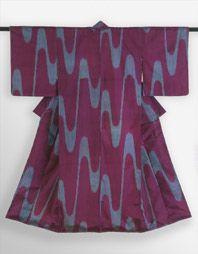
Woman’s Unlined Kimono (hitoe) Japan, 1920s–30s (late Taishō–early Shōwa period) Machine-spun silk plain weave with stencil-printed warp threads (meisen) The Montgomery Collection, Lugano, Switzerland
Women's fashionable kimono of the early to mid-twentieth century are typically decorated with large, bold designs in bright colors (using new aniline dyes imported from Europe) on a machine-spun, plain weave silk fabric. While some of these kimono designs are variations of traditional motifs—such as arrow feathers, water streams, flowers, birds, and Chinese arabesques—others reflect current styles of art in the West. When Art Nouveau became fashionable in the 1890s, it quickly spread to major urban centers in Europe and North America; this new, 'modern' style incorporated diverse sources and artistic traditions, including the Japanese use of natural forms and strong, undulating lines. This artistic fusion and mutual influence are apparent in the kimono in the exhibition, which feature dramatic lines, powerful energy, and elegant floral forms combined with scrolling arabesques.
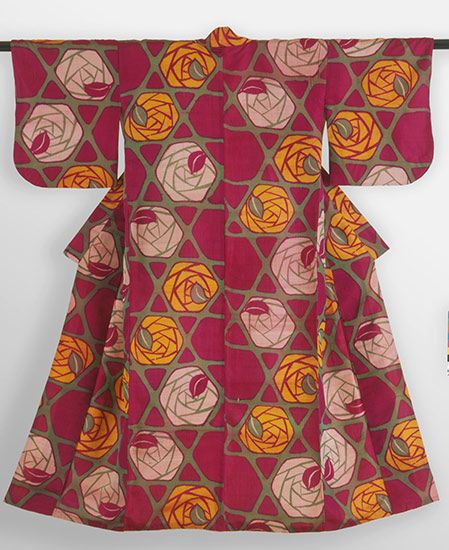
Woman’s Kimono Japan, 1912–26 (Taishō period) Machine-spun silk plain weave with stencil-printed warp threads (meisen) The Montgomery Collection, Lugano, Switzerland
In the 1920s and 1930s, when Art Deco style grew to epitomize the glamour, luxury, and hedonism of the Jazz Age, Japanese designers embraced its simplified and flattened pictorial space, and the relationship between pattern and background became central. Designers found in Art Deco a modern style partly inspired by the East, which, although novel and innovative, was essentially conservative. The Art Deco style took root in Japan because it was able to mediate between these two seemingly conflicting elements in twentieth-century culture, and this is seen clearly in kimono design. Dressing in Art Deco kimono allowed Japanese women to retain elements of tradition while embracing bolder colors and designs that reflected a more modern spirit. Other styles of visual art, including Constructivism, Cubism, and even Abstract Expressionism, also found a place in early to mid-twentieth-century kimono design.
Art Services International, Alexandria, Virginia
Joan Spain Gallery, Perelman Building
Main Building
Kristina Haugland • Associate Curator of Costume and Textiles and Supervising Curator for the Study Room and Academic Relations